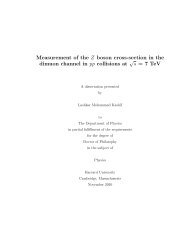2 The CDF Experiment at Fermilab Contents - Harvard University ...
2 The CDF Experiment at Fermilab Contents - Harvard University ...
2 The CDF Experiment at Fermilab Contents - Harvard University ...
Create successful ePaper yourself
Turn your PDF publications into a flip-book with our unique Google optimized e-Paper software.
82 Section 2: <strong>CDF</strong> Physics Analysis<br />
of signal eciencies (based on Pythia Monte Carlo) and the background r<strong>at</strong>es (based on \Jet<br />
20" d<strong>at</strong>a).<br />
In addition, in Run II every trigger has to have a full p<strong>at</strong>h (i.e., specied criteria <strong>at</strong> all<br />
trigger levels), so we also place a cut on Level 1 P (L1) E T . While P (L2) E T is a sum of found<br />
P calorimeter clusters, (L1) E T is just a sum over trigger towers above a threshold; the two are<br />
physically dierent quantities, the l<strong>at</strong>ter being much more sensitive to underlying event and<br />
pile-ups. <strong>The</strong> threshold for Level 1 sum is still under negoti<strong>at</strong>ions in the Trigger Working<br />
Group (currently 1 GeV), with us favoring higher values.<br />
P Fig. 40 shows the eciencies and the r<strong>at</strong>es as a function of (L2) E T given the calorimeter<br />
cuts <strong>at</strong> Levels 1 and 2, plus a requirement for two b-tags <strong>at</strong> Level 3.<br />
<strong>The</strong> Use of Tracking<br />
<strong>The</strong> lowering of the Level 2 calorimeter cuts necessarily increases the r<strong>at</strong>e for the multijet<br />
trigger. As outlined above, we cut the r<strong>at</strong>e down by making use of the tracking devices<br />
implemented in hardware: eXtremely Fast Tracker (XFT, oper<strong>at</strong>ing on COT d<strong>at</strong>a <strong>at</strong> Level 1)<br />
and Silicon Vertex Tracker (SVT, oper<strong>at</strong>ing on SVXII d<strong>at</strong>a { seeded by XFT {<strong>at</strong>Level 2).<br />
<strong>The</strong> XFT-SVT combin<strong>at</strong>ion provides measurements of p T , and d 0 for reconstructed tracks.<br />
We assume th<strong>at</strong> the set of \XFT tracks" (approxim<strong>at</strong>ed by CTC tracks of Run I d<strong>at</strong>a)<br />
th<strong>at</strong> are reconstructed in the SVX', is a good approxim<strong>at</strong>ion of an \SVT track" sample. We<br />
studied the eciencies and the r<strong>at</strong>es as a function of the number of XFT-SVT tracks, the<br />
number of displaced tracks, and the displacement for a xed number of `displaced' tracks.<br />
We found th<strong>at</strong> a cut on d 0 > 150m ontwo or more tracks, or d 0 > 100m on three or more<br />
is benecial.<br />
Future Work<br />
In order to complete this study in the near future, we plan to focus on<br />
1. A combined simul<strong>at</strong>ion of XFT and SVT: A package consisting of XFTSIM and<br />
SVTSIM is available, but awaits the SVX' alignment les from the SVTSIM experts for<br />
Jet 20 d<strong>at</strong>a. Nonetheless, it is being claimed th<strong>at</strong> the resolutions on p T and d 0 are<br />
comparable to those of the Run I oine, so we expect the nal results to be similar to<br />
our current estim<strong>at</strong>es based on Run I d<strong>at</strong>a.<br />
2. b-tagging in trigger using leptons: we will add lepton inform<strong>at</strong>ion as another basis















